If you are tired of “trickle-down” change, consider using a collaborative change process where a large slice of your organization comes together for real conversation and to make decisions about your collective future in real-time.
This kind of high-involvement process was used by Southern New England Telephone to prepare for deregulation and the emergence of competition. It was used by Jackson Hole Ski Resort to reconsider their strategic direction. It was used when the Boston Gardens closed and they opened the new Fleet Center building. It was used by the Seaport Hotel and World Trade Center when they opened under new management.
It has been used by hundreds of other organizations, where leaders understood that the attempt to hold onto power at the top of the organization would ultimately topple their efforts and that the most powerful path forward was through a high-involvement process that trusted the intelligence and commitment of the people in their organization.
There are many methodologies that bring large groups together for real conversation and decision-making, such as Real-Time Strategic Change, Open Space, and the World Cafe to name a few.
Not only is this a powerful force for change and commitment, but it is one of the most respectful ways an organization can invite the fullest contribution of its members. I am always touched and in awe of the transformation that occurs.
This is what a different way of working can look like. (Click on the pictures to see more detail).
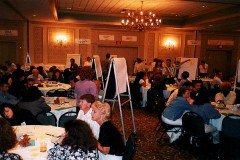 There is a room of 250 people, set with round tables. People are preassigned to tables that maximize diversity – all levels, areas of the business, roles, gender, nationality, etc.
There is a room of 250 people, set with round tables. People are preassigned to tables that maximize diversity – all levels, areas of the business, roles, gender, nationality, etc.
No one is more important than anyone else. The executives are dispersed at the tables, not sitting separately.
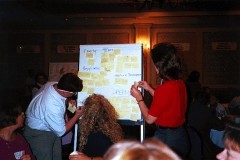 There are no motivating speakers. No boring speakers, either. People are not “talked at.”
There are no motivating speakers. No boring speakers, either. People are not “talked at.”
The information needed to do the work is shared.
Table groups tackle tough business questions. They are self-facilitated and rotate roles of time-keeper, recorder and spokesperson.
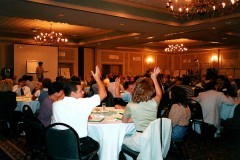 Spokespeople from tables share their thoughts, questions and conclusions with the entire room.
Spokespeople from tables share their thoughts, questions and conclusions with the entire room.
A collective view emerges.
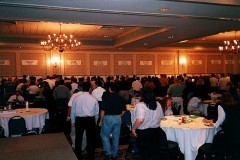 Each individual has an opportunity for their voice to be heard.
Each individual has an opportunity for their voice to be heard.
There is an opportunity to vote on issues, priorities and actions needed. Decisions are made during the meeting.
In the end … smart business decisions are made… there is deeper understanding of what is needed… there is a greater commitment for implementation… and an orientation of “me” shifts to “we.”

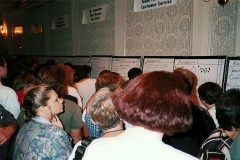












Thanks for this post. These approaches have been around for some time so its great to see them coming to the fore.
Why not sooner? My guess is that leaders have had trouble getting past the question on their lips, ‘Yes, but what if the staff make the wrong decisions?’. They miss the point you make, ‘…a collective view emerges’.
A collective view of what needs to change is better than decision-making at the top. The plan from the top may be somewhere between ideal and flawed, but we can’t know until it’s been implemented. The risk is that people, (staff / partners / stakeholders / funders / customers, et al) will take their time to become engaged in the plan. It’s also often difficult to get them to stop doing what is supposed to change. Hence, it’s probably less risky to have a collective view, take action and find what works.
I say this from experience having been using the Solution Focus approach for large-scale collective decision making for some years. At worst, it can do no harm.
Excellent points about the “risk”, Alan. I have observed the same thing. Often senior leaders are afraid of the risk of letting go of control and having the wrong decisions made, but in the end, the bigger risk is that decisions won’t be implemented because they aren’t understood or embraced by the people who need to implement them. In the long run, the quality of the decisions made during these meetings far exceeded what would have been identified by a small isolated team, because the not only is there a collective view, but also there is “collective knowledge” – that is greater than what is held by those isolated at the top.
It’s true these large group methods have been around for a long time. The search conference methodology came out of community work in Australia in the 1970’s by Fred and Merrelyn Emery. They have been elaborated upon and refined by many people over the years. Considering how powerful and effective these methods are, it is disappointing they are not more widely understood or used. That would be great if they are coming to the fore now.
Much thanks for deepening the conversation, Alan.
I just read a short piece on micromanaging by Martin Webster (www.leadershipthoughts.com), so this post is super relevant right now. Worrying about the “risk” that Alan mentions seems to be a result of mistrust (and in my experience leads to micromanaging), whereas collaboration thrives in a trust environment.
Love this post Jesse! …And for the organizations that do this: The buzz word “empowerment” transforms into real life engagement!
At one point in our lives, my husband went to work for a company that was doing this with EVERY employee from multiple locations at a significant cost. I was on the outside witnessing for the first time that the wisdom from the Blanchard books I had been reading for years was actually being applied in this organization. I was so excited and so jealous!
After investing so much in the process, the changes that resulted not only covered the cost of travel, hotels, meals, and payroll for all of these employees, it produced revenue beyond anyone’s imagination!
So glad you brought the term “empowerment” into the conversation, Chery. It empowers the entire organization when we ask people what they think, listen, and value their thinking and contributions. Thanks so much for sharing the excitement of your own experience and observations, and also for making the important point that what looks like a large cost is a drop in the bucket compared to the long term pay-off.
Outstanding method to accomplish great things I believe but it takes involvement of the entire team, not just select representatives of each department. I’ve participated in this type of change or at least that was the way it was positioned. The time spent was great, the sense of accomplishment was gratifying and we saw the light at the end of the tunnel again.
Sadly the light grew dim quickly due to the lack of follow through on everyone’s part. I believe it’s because no one was really married to the concept of collaborative change, rather they figured let’s try, what can it hurt. They weren’t in 100% and it takes 100% commitment from the top down to make it work.
Great article Jesse!
You raise an important issue, Gary. This will not be a truly collaborative process, only the illusion of one, unless these Success Factors are in place:
1) Leadership support and involvement needs to be real and clearly visible.
2) The planning group needs to represent a microcosm of the entire organization, including senior management.
3) The purpose of the meeting needs to be clear and worthwhile.
4) The “right people” need to be in the meeting – people who represent every aspect of the organization that will be impacted.
5) Commitment for follow-through and resources for implementation need to be provided.
The other important issue is that clear next steps, with timelines and accountability need to be identified or it is too easy to drop the ball as the initial excitement wears off and “creative tension” sets in.
Hi Jesse and Happy New year to all.
These and so many other tools work really well when the top of an organization realizes it needs everyone in order to grow and succeed. Despite the fact they drive change in a more organic fashion than any order will ever do they are still in fact a top down tool. In this case it is the fact that the top has decided to allow everyone else to help create and generate the future instead of trying to order up their pipe dream of what should happen.
Though I will add one point here those companies that do this share something in common with the truly Lean companies of the world, and ownership that is more concerned with long-term growth than short-term return. It is truly sad though that so few companies will ever do either Lean or look to involve their staff at all levels in driving their collective future, simply because far to many are either slave of the short-term stock market, or owned by ego case founders (or their families). The use of this type of mass brainstorming, or true Lean takes humble management and ownership that believe their success depends upon everyone else succeeding as well.
Much thanks for your thought-provoking comments, Robert. I am still mulling over your comment that the fact of top leadership allowing this process is in itself a top down decision. Your comments beg the question of whether a hierarchical organization can ever really use a collaborative change process. I think I personally land somewhere in the middle of this. Although the hierarchy remains, I think that it does have a real impact on making the environment more human, and it doesn’t seem to rubber band back quite so rigidly.
But I agree with you that the ideal is to create collaborative organizations. Then these kinds of processes are just the everyday way of getting work done. It’s much easier for a company to build itself from the beginning in a collaborative model, e.g. Morning Star and Valve). And it’s not so easy to convert an existing organization. Paul Green at Morning Star reported that although many have come to learn, no one has gone back restructured their company. As for why so few companies are willing to become self-managing, this excellent Forbes article by Drucker Institute staff discusses the reasons you listed. I think you will find it interesting, if you haven’t read it already. And, it will be interesting to see what happens at Zappos.
Much thanks for steering the conversation in this direction, Robert.
Great post Jesse!
Thanks, Sofia. Glad you found it helpful.
Jesse, I couldn’t agree more. This year, my company rolled out the 3cs – Collaborative. Competitive. Compassionate. We’re challenging each other to let our guards down, admit what we don’t know and learn from one another. I know that TOGETHER, we can build something really special….and it all starts with collaboration. We host company-wide meetings that encourage transparency. We empower our staff to voice their opinions and concerns. We meet in small groups and large groups, one on one sessions and team meetings. Everything we do is centered around collaboration. Here is a link to some photos from the most recent company-wide meeting we hosted. Our goal is always to create a safe, fun space for our employees to learn, grow and collaborate. https://www.facebook.com/media/set/?set=a.10152128962542370.1073741835.82095877369&type=3
Thanks for sharing your own experience, Tom. Great stuff! As I’m sure you know, the real power is when you ask your people to be involved in the process – to help identify what it would look like if the company was living the 3cs, to identify the roadblocks that need to be addressed, and what they need from management and what they will each personally commit to doing.